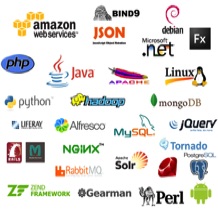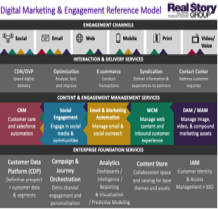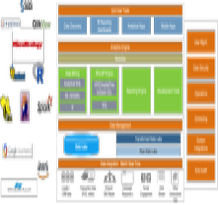1 Cloud Business Models
Service Models We've identified 2 Cloud Platforms used for IT operations (developer,
infrastructure, in black) and 4 Web Platforms used for business operations (martech,
office, product, payment, in yellow). There are 14 products (in brackets) equally split between
both platform families. They can be in turn grouped into 3 service models with the following
functions: i) operating function to run the applications, on an Infrastructure IaaS platform,
ii) development function to build the user, data and web applications on a Developer
PaaS platform, iii) consumption function to consume the applications on a User SaaS
platform. We showcase Microsoft's and IBM's product lineups for all 3 service models
Deployment Models A firm can choose to operate all 3 of the above service models according
to 3 infrastructure deployment models: Private Cloud, Public Cloud, or Hybrid Cloud. It used
to be that a firm had to have, at extra cost, physically on its premises or "on-site", a room and
staff to operate a computer (i.e. an IBM AS400 minicomputer), which it also had to pay for,
generally in the form of a lease. Operating and business software also had to be leased
But today, all computers are in the Cloud, that is, they are physically located "off-site"at the
data center of a Cloud Service Provider (i.e. AWS), miles away but still as easily and as
instantly accessible and usable as when they were in the firm's office building. The very same
staffing, computer room, the computer hardware and software costs have become computer
resources on demand, that one still leases, in the form of a lump-sum monthly subscription fee.
To the extent that usage time is more or less the same every month, the cost of time-based pricing
which the Cloud now offers, is more or less the same as what a firm incurred previously with the
fixed monthly lease (leasing cost on the capitalizable goods and rental cost on the services)
The Cloud being a remote solution, what does one mean by a remote Private Cloud as opposed
to a remote Public Cloud. It simply reflects the Cloud's 2-tier security system. The first tier
is the security system of the Public Cloud's data center facility, where the computers are now
located. The second tier is that of the Private Cloud, where there is an extra level of protection,
generally of a firm's most sensitive data, over which it wants to have sole control
Revenue Models (Monetization) The 3 most popular revenue models are transactional (Amazon, consumer, NFTs), advertising (Facebook, social), and subscription (Microsoft, business, gaming)
We now turn to a short description of each of the 4 Web platforms (Martech, Office,
Product, Payment) and of the 2 Cloud Platforms (Infrastructure and Developer)
2 Martech Platforms (Web platforms)
Because it is the most important Web platform, we've devoted an entire page
to describe in detail the Martech or Marketing Technologies Platforms
3 Office Platforms (Web platforms)
These are workplace relationship platforms, virtual and physical. Regarding virtual workplace platforms in the Cloud, vendors have put together a market offering which combines and seamlessly interconnects the latest communications, call center, document management, productivity tools and the direct interfaces to the ERP into what they call a Workflow or Collaboration platform (MS Office 365, Slack), providing for improved communications and interactions, internally between employees and externally with the customer. One is also beginning to see the emergence of "vertical" workflow platforms, developed for very specific markets, notably in education with Digital Education platforms (Hivebrite, Drupal site builders and Coursera platform). Regarding physical workplace platforms, this pandemic has reshaped our market adoption of the Shared Workspace platforms and Homeworking
4 Product Platforms (Web Platforms)
These are industrial or manufacturing platforms tasked with making the"smart" and connected physical products. They build tomorrow's home appliances, houses, buildings, cities, utility grids, transport vehicles, machinery and factories. These products are generally embedded with a semiconductor chip, hence the name they adopted. They are "co-engineered", requiring engineers from numerous other fields to work hand in hand with the software and hardware engineers from ITC. Industrial IoT (or Industry 4.0) and Robotics platforms drive growth in the industrial market. At the beginning of the value chain is the electronics industry led by semiconductors. See Robert Bosch IoT, Zongshan Industrial IoT Open, Alibaba/Siemens Mindsphere, Tesla
5 Payment Platforms (Web Platforms)
Mobile apps such as Google Pay, Apple Pay, and more recent upstarts such as Block have been around for some time. However, they are still dependent on our age-old credit card value chain comprised of the credit card issuers (the big banks) who take home at least 50% to 60% of the revenue stream, followed by the credit card merchant processors such as Visa and Mastercard and lastly the giant credit card data processors such as First Data. As we know, mobile payments come at the very end of this chain, as a barcode reader, replacing the POS machine. On the heels of eCommerce, Search, and Social Media, the next revolution for the consumer will be in ePayments, in the form of Central Bank Fiat Digital Currencies. Cryptocurrencies do not qualify
6 Infrastructure Platforms (Cloud Platforms)
AI Platforms provide the application software. Programs are generally coded in the same object programming languages derived from C, Python and Java being the most popular. With most programs, the computer executes only those tasks it is instructed by the program to do. With the more recent AI software programs, such as Facial and Voice Recognition, the computer is able to learn by itself (hence the term machine learning), performing tasks without being explicitly instructed by the program. By contrast, Cloud Platforms provide the underlying infrastructure hardware and software, data centers and mobile devices being prime examples. Cybersecurity is a top strategic consideration
7 Developer Platforms (Cloud Platforms)
To develop their customers' user applications, developers have access to the technologies and tools they need on their own developer platforms. As shown in more detail on our Internet page, these developer platforms are generally either developer, data analyst, or designer platforms
8 Market Size and Growth
As shown below, the 14 Platform products described above are regrouped into the 6 product families of our investment scope
They account for nearly $13T of market cap on the NASDAQ and NYSE with the top 100 firms out of some 900 taking 80% of total sales. They generate $4.5T of annual sales and $750B of operating income, and employ 2.5M employees. The sector is expected to grow at a compounded annual growth rate of 15%
Each one represents a standalone strategic business unit (SBU) or strategic group along
the entire value chain, as described on the Strategy page

Infrastructure
Platforms
1. AI & Data Analytics
2. Security/Blockchain/APIs
3. Internet Infrastructure
4. Mobility
Martech
platforms
8. Customer Platform (marketing tech)
9. ERP Platform
(enterprise tech)
Office platforms
10. Workflow
11. Digital Education
12. Shared Workspace
Product platforms
13. Industrial Internet of Things
Developer
Platforms
5. Developer
6. Data Analyst
7. Designer
Infrastructure (hardware)
AI, Mobile & Cloud (software)
The Web (services)
Digital
currencies
(fiat not crypto)
Smart objects
Collaboration
Applications
Payment
Platforms
Product
platforms
Office
platforms
Martech
platforms
Developer Platform Data Analyst Platform Designer Platform
Cloud Platforms
3. Internet
Infrastructure
4. Mobility
AI Platforms
1. AI/Data Analytics
2. Security/
Blockchain/APIs
Infrastructure AI & Cloud The Web
1. Programming Languages (Python) 5. AI Analytcis Languages (Hadoop) 9. Web Languages (HTML)
2. Mobile Operating Sytems (Android) 6. Mobile Devices (Tesla) 10. Mobile Apps (Whatsapp)
3. Chip Platforms (RISC) 7. Cloud Platforms (AWS) 11. Metaverse Platforms (3D, VR)
4. Internet Infrasctructure (TCP/IP) 8. Internet Ops (Telcos) 12. Internet Apps (AirBnB)
THE 12 Technologies
Developer
Platforms
5. Developer
6. Data Analyst
7. Designer
BUSINESS SIMPLIFICATION
IBM now markets itself under one brand, Hybrid Cloud, and around 2 businesses, Cloud Platform (IBM Software) which helps firms move their IT operations to the Cloud and Web Platform (IBM Consulting) which helps them digitize their business operations. Beginning 2021, it released on one platform, the IBM Cloud Paks, a full line of tools to develop, deploy, and run applications over the Cloud. It is spinning off its 3rd business in Cloud Operations, renamed Kyndryl, in spite of its size ($19B sales), possibly because it is a low margin business
Its New Business Model is the same one that has made the company it acquired, Red Hat, so successful in growing its own Cloud business. It is based on 3 rules, now generic throughout the industry: self-service (the customer does it himself, so that he can react speedily to changes in the marketplace), modular (he works on any module, at his own pace), pay-as-you-go (he only pays for the time he spends on the platform)
IBM has two true Hidden Gems: i) its Supercomputer and Chip businesses and ii) its IBM Fellows program. It is through them that it has been able to maintain its technological lead over its rivals in such cutting-edge areas as AI, quantum computing, and chips
IBM's Strategic Realignment
Infrastructure Platforms
AI Platforms (AI/Analytics, Security/Blockchain/APIs) Cloud Platforms (Infrastructure, Mobility)
Payment
Platforms
(Digitlal
Currencies,
fiat not cypto)
Product
Platforms
(Industrial IoT)
Office
Platforms
(Workflow,
Digital Education, Shared Workspace)
Martech
Platforms
(Customer,
ERP)
Developer
Platforms
(Developer,
Data Analyst, Designer)
Cloud Service Models
(the business decision)
Payment
Platforms
14. Digital Currencies
Central Bank Fiat
Digital Currencies
(not crypto)
Fintech
Cloud Platforms
Web Platforms
Cloud Platforms
Metaverse Platforms
Dynamics (Connected Space)
Bing
Activision
Office 365 (Copilot)
Teams (Mesh)
Skype
Power BI
365 Guides
Azure IoT & Cognitive
Power Platform
Hololens
Microsoft Pay
Microsoft's Offering
Network Services (5G, Edge, IoT), Security
Technology Services (middleware,...) IT Infrastructure Services
BUSINESS SERVICES
Apps Portfolio Management, Intelligent Workflows, RPA
Application Operations Technology Consulting
MARKETING SERVICES
Customer Experience (IBM iX), Talent Management (HR, Change Mgmt) Smart Contract Blockchain
Cloud Infrastructure Operations
Appendix - The 14 Cloud Platforms
WEB PLATFORMS
(SaaS)
Martech Platforms
8. Customer (marketing tech)
9. ERP (enterprise tech)
Office Platforms
10. Workflow
11. Digital Education
12. Shared Workspace
Product Platforms
13. Industrial IoT
Payment Platforms
14. Central Bank Fiat Digital Currencies (not crypto)
Our investment scope covers the Cloud's entire value chain, comprised of 2 building blocks:
i) upstream are the Cloud Platforms, which are essentially Infrastructure Platforms at the back-end. They help firms develop, deploy, and run their Cloud operations and Cloud applications,
ii) downstream are the Web Platforms, which are essentially User Platforms at the front-end. They help firms develop, deploy, and run their customer-facing Cloud applications. Functionally, these are essentially customer-facing Martech or Marketing Technologies Platforms, albeit upgraded with the latest 3D AR/VR technologies
THE PRODUCTS
The Technologies
AI, Data, Cloud, Security
(Product Innovation)
The Market Offering
The Brand: IBM Hybrid Cloud
The Products: Cloud Platforms
IBM Cloud Paks
The Technologies
AI, Data, Cloud, Security
(Product Innovation)
The Solutions & Services
Automation, Operations
The Products (any app)
1500 customizable products
IBM Cloud Paks, Watson, Red Hat OpenShift
The Products (any app)
Digitization of Business Functions and Processes
Industry Applications (healthcare, financial services,...)
The Solutions & Services
Business, Digital and Cloud Design, Workflow, Talent
The Market Offering
The Brand: IBM Hybrid Cloud
The Products: Digital Transformation
IBM Cloud Paks
Cloud Platforms
to move IT operations to the Cloud
Web Platforms
to digitize business operations
Industry Standards &
IBM Differentiation
Industry Standards &
IBM Differentiation
Spin-Off
CLOUD SERVICES
The Technologies
The Business Model
The Products
AI
Data
Cloud
Security
Self-Service
Modular
Pay-As-You-Go
Microsoft Azure (security stack at 5 device, Cloud, data, network and app levels: Azure Sentinel, MS Defender, End-Point Manger, Active Directory)
Payment
Platforms
(Digital
Currencies,
fiat not
crypto)
Product
Platforms
(Industrial IoT)
Office
Platforms
(Workflow,
Digital Education, Shared Workspace)
Martech
Platforms
(Customer,
ERP)
Developer
Platforms
(Developer,
Data Analyst, Designer)
Web Platforms (user)
IBM
Cloud Paks
IBM Watson
IBM Consulting & Services
IBM RPA
(robotic
process automation)
IBM Products
& Solutions
IBM FIntech
IBM Hybrid Cloud & Kyndryl
Web
Platforms
Infrastructure Platforms
Developer Platforms
Infrastructure Platforms
PaaS
SaaS
IaaS
IaaS: Public, Private or Hybrid Cloud
Cloud
Platforms
3. Internet Infrastructure
4. Mobility
AI Platforms
1. AI/Data Analytics
2. Security/
Blockchain/APIs
Infrastructure Platforms
(ChatGPT/Codex)
IBM's Offering
Infrastructure Platforms
AI Platforms (AI/Analytics, Security/Blockchain/APIs) Cloud Platforms (Infrastructure, Mobility)
Click on above picture for pdf
CUSTOMER ENGAGEMENT
IBM offers an all-in-one AI, Data, Cloud, Security portfolio of its own products, solutions and services to meet a firm's needs. Where it has a competitive advantage over its competitors is in research with IBM Research, in execution with Red Hat and in AI with Watson. It engages the customer across the entire portfolio. Cash Flow IBM's Q4 2021 earnings presentation shows double digit revenue growth in Cloud Platforms (Red Hat+21%, Transaction Automation +19%) and in Metaverse platforms (both end-user and developer markets at +20%). To finance its growth, its cash flow is expected to double to about $7B-$8B a quarter, after its $19B of bond debt for the Red Hat acquisition will be gradually paid off. The spinoff of Kyndryl has also freed up cash flow
Web Platforms
INFRASTRUCTURE PLATFORMS (IaaS)
AI Platforms
1. AI/Data Analytics
2. Security, Blockchain, APIs
Cloud Platforms
3. Internet Infrastructure
4. Mobility
DEVELOPER PLATFORMS (PaaS)
Developer Platforms
5. Developer
6. Data Analyst
7. Designer
Cloud Platforms (system)
Web Platforms (user)
Cloud Platforms (system)
Web Platforms (user)
Cloud Platforms (system)
Web Platforms (user)
Cloud Platforms (system)
Web Platforms (user)
Cloud Platforms (system)
IBM Cloud Paks
(Installation)
Cloud Deployment Models
(the economic decision)
Secured AI
ChatGPT
/Codex
ChatGPT/Codex
ChatGPT/Codex
ChatGPT/Codex
ChatGPT/Codex
Microsoft AI
Secured AI
IBM Watson
The Cloud
Computer Resources On Demand
Copilot is a ChatGPT add-on in Office 365
To contact us
Or Man Partners


